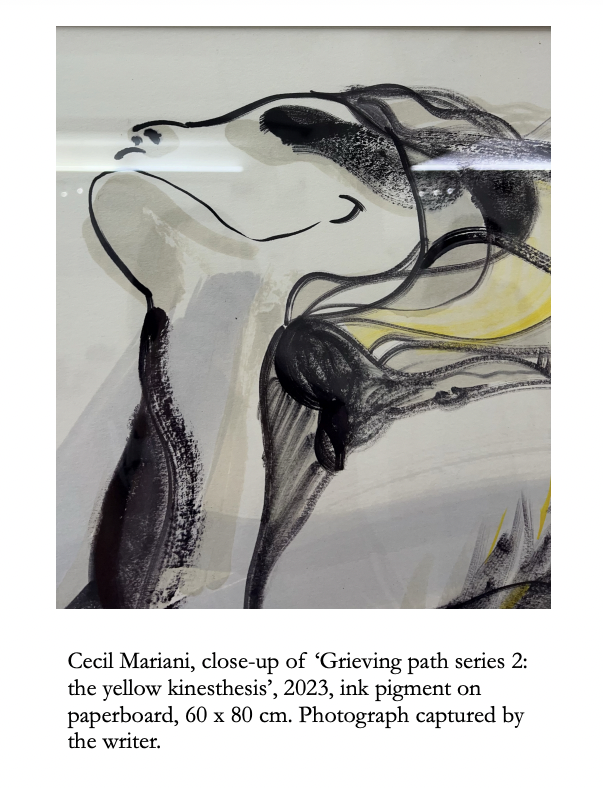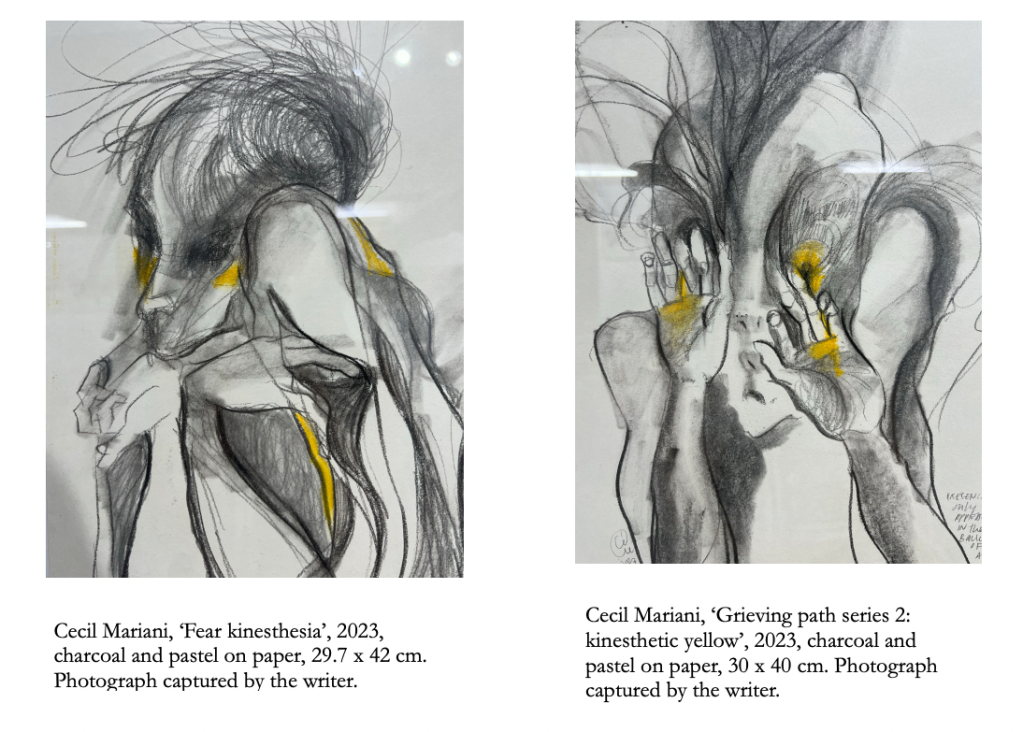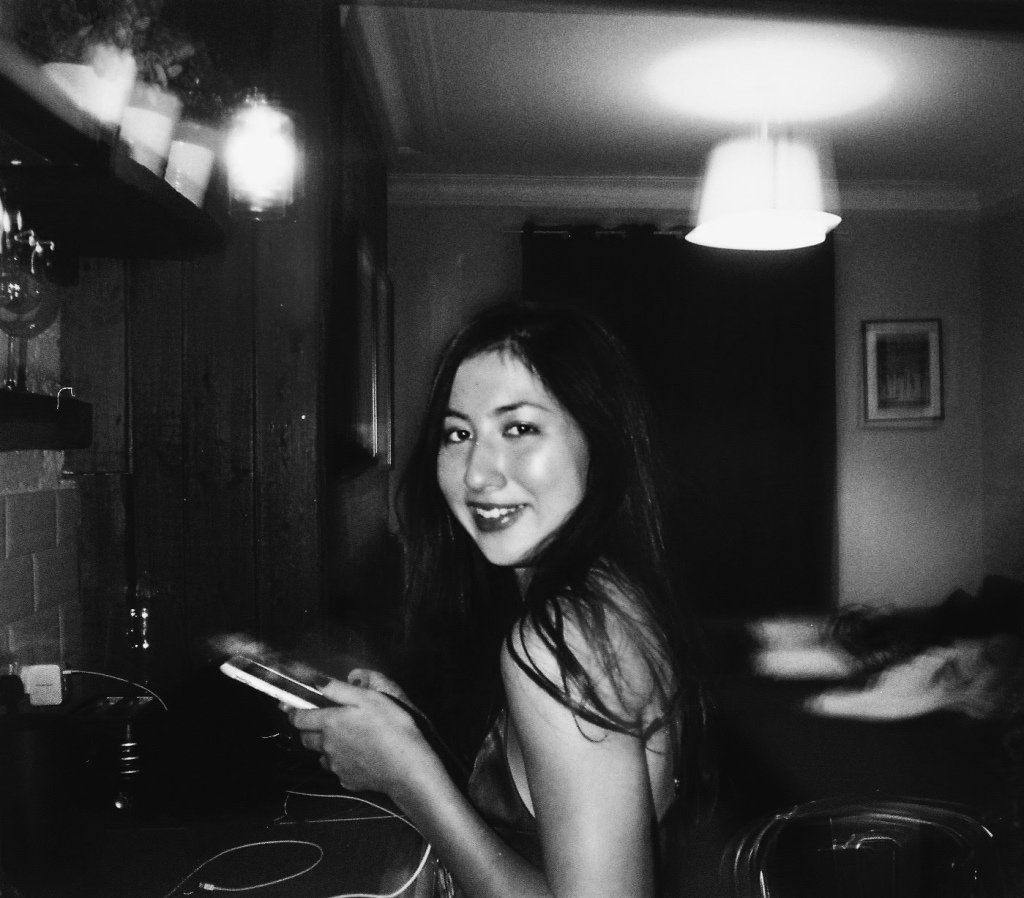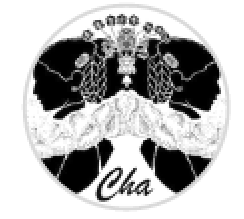📁 RETURN TO FIRST IMPRESSIONS
📁 RETURN TO CHA REVIEW OF BOOKS AND FILMS
Cecil Mariani, Gaze, Grace, Grief, RUBANAH – Underground Hub, 2023.

When my friend Tara and I walk into the RUBANAH Underground Hub on a humid afternoon in Jakarta, we find the gallery in a state of undress. The washed concrete floor is immaculate. White walls pulsate in an almost discomfiting blank freshness. There are stools littered below frames that hang in glamorous disarray, half-sheathed in bubble wrap. The manager tells us the gallery is actually closed today, that they are preparing for the opening of Cecil Mariani’s solo exhibition, Gaze, Grace, Grief, tomorrow. We nod, smile, make as if to leave, but she says that we can still look around if we like. It’s no problem at all.
There is something thrilling about being in a gallery that is not quite ready to receive visitors. It is like stumbling upon someone who always looks effortlessly put together at their dressing table, with their hair up and their makeup half done—the fleeting glimpse behind the veil doesn’t so much detract from their allure as enhance it. Something so deliciously clandestine about watching a space become itself. In a way, the gallery’s dishevelled composure cultivates the perfect conditions to encounter Gaze, Grace, Grief, an exhibition that seems to speak to a quiet unravelling of the self and its boundaries. We walk through the gallery at separate paces, navigating different imaginary pathways around the walls and pillars. We are visitors in every sense of the word, not just to the gallery but to the city and also the country: Tara from Singapore, I from Kuala Lumpur. Jakarta is our meeting point on this occasion, the bubbly space that holds our friendship—largely one of pixelated screens and bad Wi-Fi connections—in lithe physicality for a few days.
Gaze, Grace, Grief consists of a series of drawings in charcoal, pastel, ink, and acrylic, the colours muted hues of yellow, pink, and grey. It is an exhibition of curves and edges. Mariani’s drawings depict ethereal figures in various poses—some look like ghosts; some like sketches from a designer’s lookbook. I think of a line from “The Glass Essay”, Anne Carson’s prose poem that is about, among other things, a devastating heartbreak and Emily Dickinson: the in-between space she notes “where the little raw soul / slips through”. Mariani’s rhythmic figures that are often stripped down to their bare bones bring to mind this notion of a little raw soul slipping through some indiscernible crack: heads tipped skyward in gaunt ecstasy; shoulders hunched up to the ears and chins cupped pensively in palms; hair swirling around shadowy faces in sombre spirals.

It is Mariani’s hands, though, that fascinate me. How they are expressive to the point of despair. While her faces are almost featureless, her forms so skeletal as to beg the question of whether these figures are spectres haunting some stultifying scene, her hands thrum with life: a wrist pressed broodingly against a chin, fingers curled into what looks like a devastatingly gentle fist, knuckles lightly covering eyes that seem to be leaking yellow dust. Their elegance and humanity is almost bewildering. Each limbic gesture feels like someone unfurling their body to the sound of some unseen music.

The curatorial text for Gaze, Grace, Grief is bookended by two brief messages from Mariani’s friends, one writing from Jakarta, the other from Berlin. There is a languor to their loveliness, one that feels stretched out and sleepy with well-worn intimacy, like a favourite pair of socks. In the first message, Ening Nurjanah writes about morning text exchanges between her and the artist, centred around breakfast. She details the food from their communal time, its evolution from “a waffle, or a pancake, and an omelette for two. A white coffee for me and a cup of tea for her. Some cigarettes” to “two black coffees, one salade chèvre chaud, shakshouka, some bread. And, no more cigarettes!” “These conversations still happen, despite the lesser intensity, the different breakfast places, the different menus,” Nurjanah writes. “From Central to South! Brekky-time with Cecil is always special.” The second message by Lisabona Rahman, all in lowercase, reads almost like a poem: “the last time we talked, just us / everything was choked up, crammed / just as the traffic jam that entrapped us that afternoon”. She recalls a conversation with Mariani: “‘where do you feel most relieved?’ i asked / ‘when i can draw’ you replied”.
I ponder the choice to include these vignettes in the curatorial brief, and then I stop and decide that there cannot have been any other way. Wandering through Cecil Mariani’s art in a gallery that is coquettishly half-dressed and otherwise deserted with Tara, a friend with whom I have shared and observed many quiet inner catastrophes, and one of the people, it must be said, whom I love the most in the world, it feels like time has condensed into a moment curated just for us. Gaze, Grace, Grief, with its beautiful, caressing hands, its soulful portraits of people on the brink of something that is never quite named—something perhaps not entirely nameable—feels made for these moments of tender intimacy between friends: of breakfasts eaten and time thoughtfully spent together, of traffic jams endured and conversations on what brings you not joy, but solace.
How to cite: Merican, Julia. “Gaze, Grace, and Grief: Gallery in A State of Undress.” Cha: An Asian Literary Journal, 29 Aug. 2023, chajournal.blog/2023/08/29/gaze-grace-grief.



Julia Merican is a writer and researcher from Kuala Lumpur. She often finds herself thinking about the allure of transitory or ruined spaces, writing that trickles outside of generic boundaries, and unlikely spaces of reconciliation. Her work has appeared in the pages of several print magazines and various online publications, and once, quite excitingly, on the walls of an art gallery. She writes about art, design, film, literature, and little things that are less easy to define, like letters found in second-hand books, or how sunlight falls onto brick walls. You can scroll through her written archive at juliamerican.carrd.co.



















